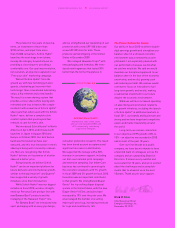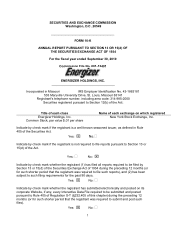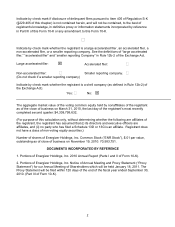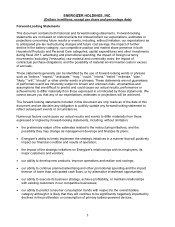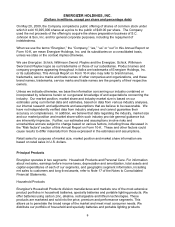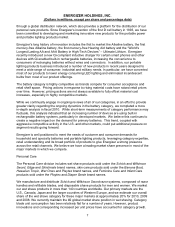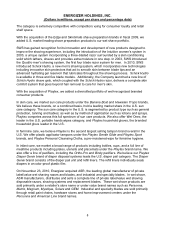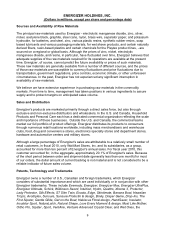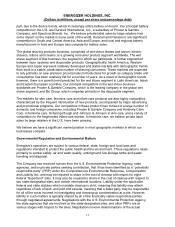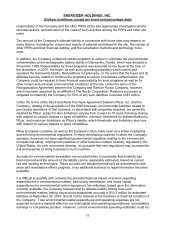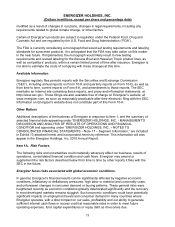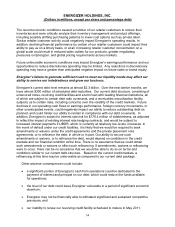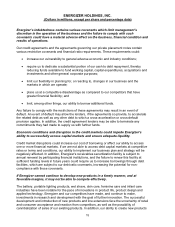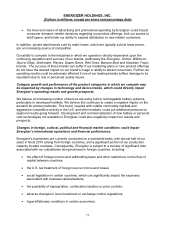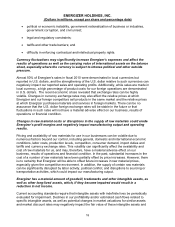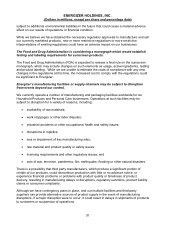Energizer 2010 Annual Report Download - page 20
Download and view the complete annual report
Please find page 20 of the 2010 Energizer annual report below. You can navigate through the pages in the report by either clicking on the pages listed below, or by using the keyword search tool below to find specific information within the annual report.
ENERGIZER HOLDINGS, INC.
(Dollars in millions, except per share and percentage data)
10
Energizer Bunny and the Energizer Man character. As a result of the Playtex acquisition,
Energizer also owns royalty-free licenses in perpetuity to the Playtex and Living trademarks in
the United States, Canada and many foreign jurisdictions related to certain feminine hygiene,
baby care, gloves and other products, but excluding certain apparel related products.
Energizer’s ability to compete effectively in the battery and portable lighting, wet shave, skin
care, feminine care and infant care industries depends, in part, on its ability to maintain the
proprietary nature of its technology and manufacturing processes through a combination of
patent and trade secret protection, non-disclosure agreements, licensing, and cross-licensing
agreements. Energizer owns or licenses from third parties a considerable number of patents,
patent applications and other technology which Energizer believes are significant to its
business. These relate primarily to battery product and lighting device improvements, additional
battery product features, shaving product improvements and additional features, plastic
applicators for tampons, baby bottles and nipples, disposable liners and plastic holders for the
nurser systems, children’s drinking cups, pacifiers, sunscreen formulations, diaper disposal
systems, and breast pump products and improvements, and manufacturing processes.
As of September 30, 2010, Energizer owned (directly or beneficially) approximately 1,100
unexpired United States patents which have a range of expiration dates from June 2011 to
June, 2027, and had approximately 300 United States patent applications pending. It routinely
prepares additional patent applications for filing in the United States. Energizer also actively
pursues foreign patent protection in a number of foreign countries. As of September 30, 2010,
Energizer owned (directly or beneficially) approximately 2700 foreign patents and had
approximately 1,200 patent applications pending in foreign countries. The above totals do not
include ASR patents.
Since publications of discoveries in the scientific or patent literature tends to lag behind actual
discoveries by several months, Energizer cannot be certain that it or its subsidiaries were the
first creator of inventions covered by pending patent applications or the first to file patent
applications on such inventions.
Seasonality
Sales and operating profit for Household Products tends to be seasonal, with increased
purchases of batteries by consumers during the December holiday season, and increases in
retailer inventories during autumn. In addition, natural disasters such as hurricanes can create
conditions that drive increased needs for portable power and spike battery and flashlight sales.
The wet shave business does not exhibit significant seasonal variability.
Customer orders for sun care products are highly seasonal, which has historically resulted in
higher sun care sales to retailers during the late winter through mid-summer months.
Competition
The Household Products and Personal Care businesses are highly competitive, both in the
United States and on a global basis, as large manufacturers with global operations compete for
consumer acceptance and, increasingly, limited retail shelf space. Competition is based upon
brand perceptions, product performance, customer service and price.
Unit growth in the battery category had been positive for many years, but unit volume declined
on a year-over-year basis over the last few years as overall category consumption declined, in


